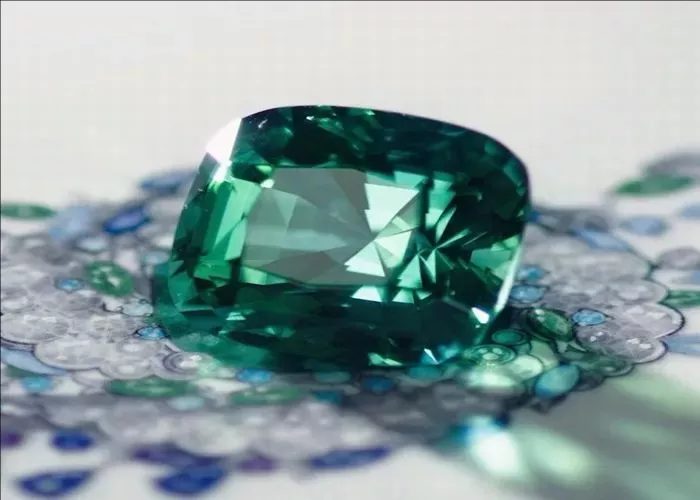Green tourmaline from Zambia has become increasingly popular in the global gemstone market. Known for its vibrant hues ranging from light mint to deep emerald green, Zambian tourmaline offers excellent quality at competitive prices. This article provides a comprehensive look at current pricing, quality factors, mining locations, and market trends for Zambian green tourmaline.
Understanding Zambian Green Tourmaline
Zambia produces some of the world’s finest green tourmalines. These gems form in the country’s rich pegmatite deposits, particularly in the Copperbelt and Eastern provinces. What makes Zambian tourmaline special is its exceptional clarity and color saturation. Unlike some other sources that produce darker or more included material, Zambian stones often display that perfect balance of tone and transparency that jewelers desire.
The green color comes from natural traces of iron and vanadium in the crystal structure. Some Zambian tourmalines may show slight color zoning, where different intensities of green appear in the same crystal. When cut properly by skilled lapidaries, these stones can rival the finest emeralds at a fraction of the price.
Current Price Ranges for Zambian Green Tourmaline
As of today, Zambian green tourmaline prices vary significantly based on quality. Here’s a general price guide:
Commercial grade stones (slightly included, lighter color) sell for $10-30 per carat. These are typically used in mass-market jewelry where perfect clarity isn’t essential.
Good quality stones (eye-clean, medium green) range from $50-150 per carat. This represents the bulk of the Zambian tourmaline market and offers excellent value.
Fine quality gems (vivid green, excellent cut) command $200-500 per carat. These are collector’s pieces that may be certified by gemological laboratories.
Exceptional top-grade specimens with perfect color and clarity can reach $800-1,500 per carat, especially for larger stones over 5 carats.
It’s important to note that prices fluctuate based on global demand, mining output, and currency exchange rates. The Zambian kwacha’s value against the US dollar directly impacts export prices.
Factors Determining Value
Several key factors influence the price of Zambian green tourmaline:
Color remains the most important value factor. The most prized stones show a pure, vivid green without gray or brown modifiers. Stones with bluish-green hues (reminiscent of Paraiba tourmaline) command premium prices.
Clarity significantly affects value. While some inclusions are expected in tourmaline, eye-clean stones fetch much higher prices. Needle-like inclusions that don’t impact transparency are generally accepted.
Cut quality makes a major difference. Well-proportioned stones that maximize brilliance and color sell for 20-50% more than poorly cut material of similar quality. Zambian cutters have developed excellent expertise with these gems.
Carat weight follows the standard gemstone pricing curve – prices increase exponentially as size goes up. A 5-carat stone will cost significantly more per carat than a 1-carat stone of equal quality.
Treatment status impacts value. While most Zambian green tourmaline is untreated, some stones undergo heat treatment to improve color. Disclosure is essential, as untreated stones command 15-30% premiums.
Major Mining and Trading Centers
Most Zambian green tourmaline comes from small-scale mining operations in the following regions:
The Copperbelt Province remains the primary source, particularly around the Ndola and Kitwe areas. These mines produce consistent material favored by international buyers.
Eastern Province deposits near Lundazi yield exceptional quality stones, though production is more sporadic. The famous “emerald green” tourmalines often come from this region.
Lusaka serves as the main trading hub, where miners bring rough material to sell at gem markets. Serious buyers can find better deals by visiting mining areas directly, though this requires local connections.
Market Trends and Future Outlook
The Zambian green tourmaline market shows several interesting developments:
Demand from China has grown dramatically in recent years, particularly for stones in the 1-3 carat range suitable for jewelry manufacturing.
Ethical sourcing has become increasingly important. Many international buyers now seek stones with traceable origins and fair labor certifications.
Cutting expertise in Zambia has improved significantly. Locally cut stones now command better prices as quality approaches Thai and Indian cutting standards.
New discoveries continue to be made. Recent finds in previously unexplored areas suggest Zambia’s potential as a tourmaline source is far from exhausted.
Investment potential looks promising. High-quality Zambian green tourmaline has shown steady appreciation, with prices increasing 8-12% annually for top material.
Buying Tips for Zambian Green Tourmaline
When purchasing Zambian green tourmaline, consider these professional recommendations:
Always examine stones under multiple light sources. Zambian tourmaline can show dramatic color changes between daylight and incandescent lighting.
Request documentation of origin. Reputable dealers should provide mine information and any available certification.
Consider buying rough for custom cutting. Zambian rough often offers excellent value compared to cut stones.
Build relationships with local suppliers. The best deals often go to buyers who establish long-term partnerships with miners.
Factor in all costs. Remember to account for duties, shipping, and potential recutting expenses when calculating your total investment.
Conclusion
Zambian green tourmaline represents one of the best values in today’s colored gemstone market. With its combination of beautiful color, good availability, and reasonable pricing, it has become a favorite of jewelers and collectors worldwide. While prices have risen in recent years, Zambian tourmaline still offers exceptional quality at accessible price points compared to similar gems from more established sources.
As Zambia’s gemstone industry continues to develop and gain recognition, we can expect to see even finer material reaching the market. For anyone interested in colored gemstones, Zambian green tourmaline deserves serious consideration as both a jewelry staple and a potential investment opportunity. The country’s deposits have already proven their ability to produce world-class material, and with proper management, they should continue to do so for years to come.
Related topics:


